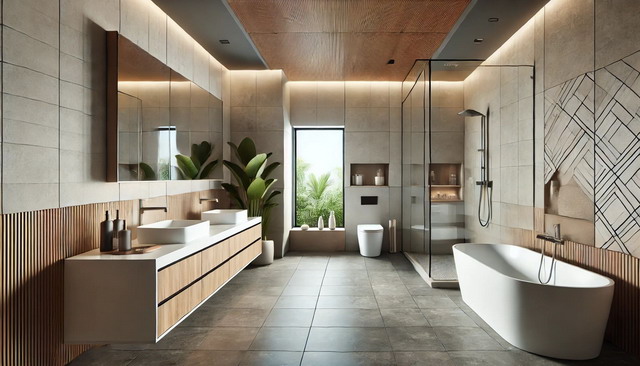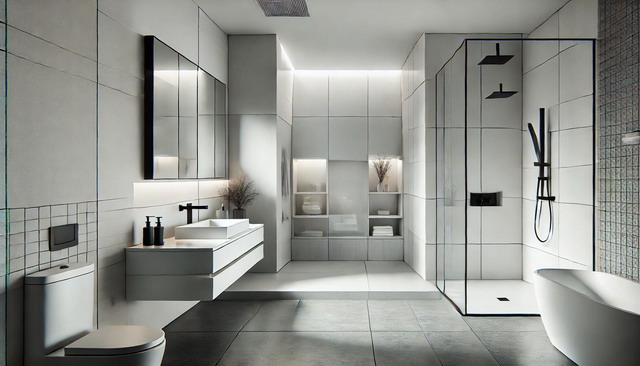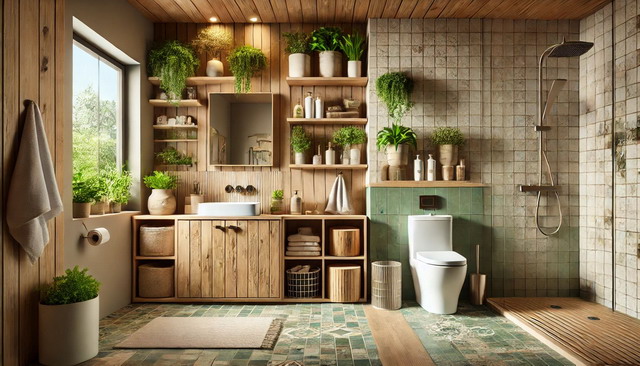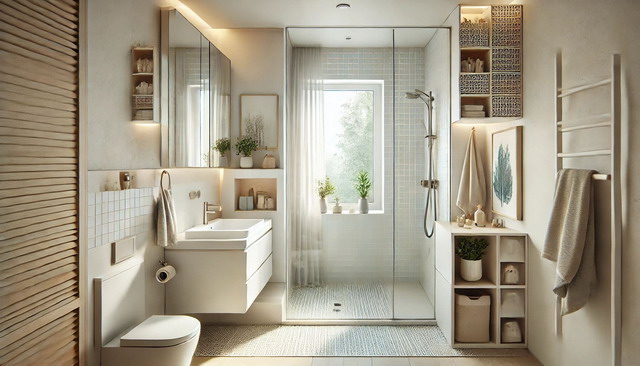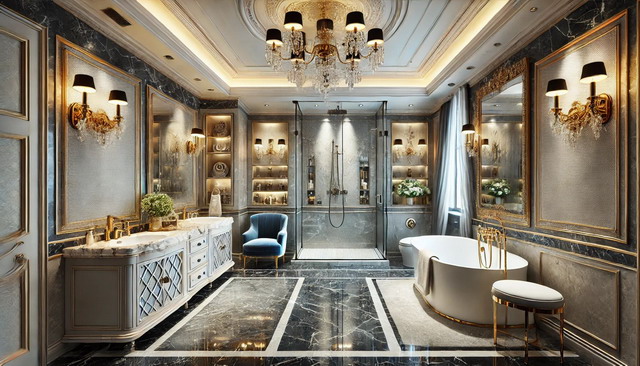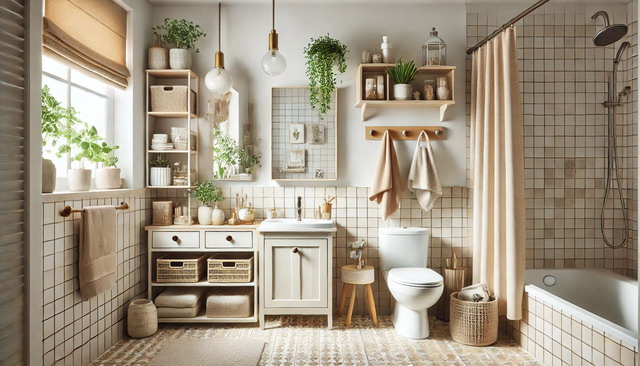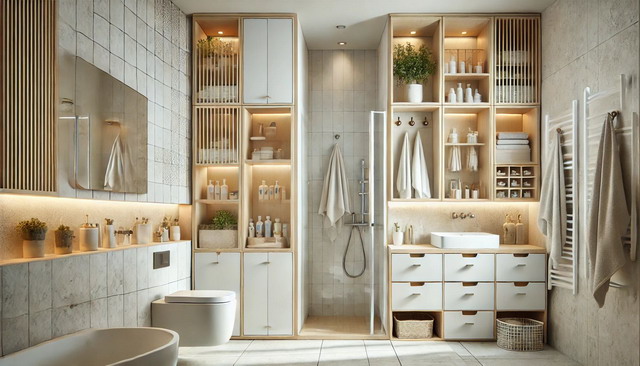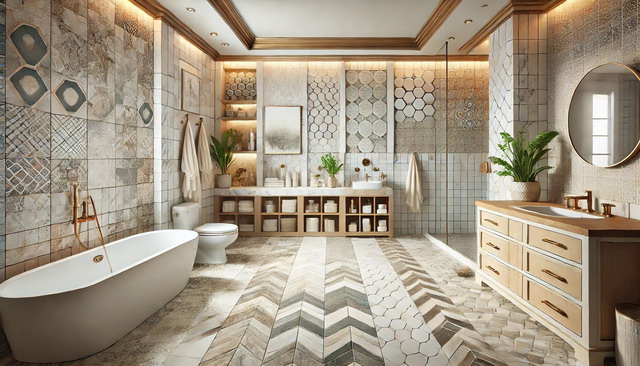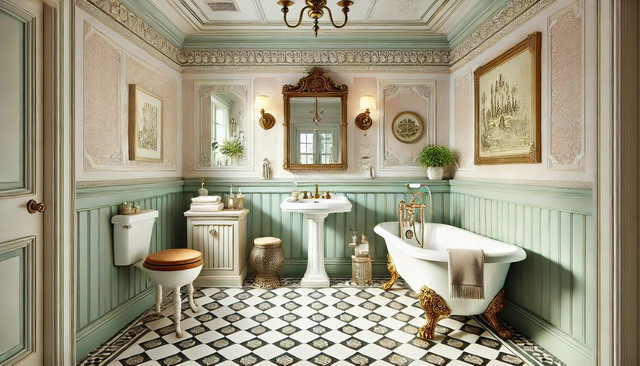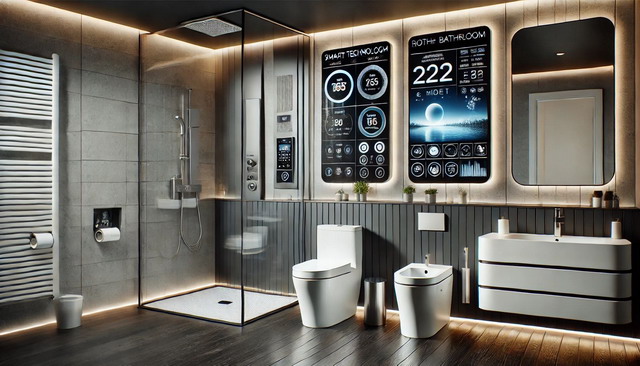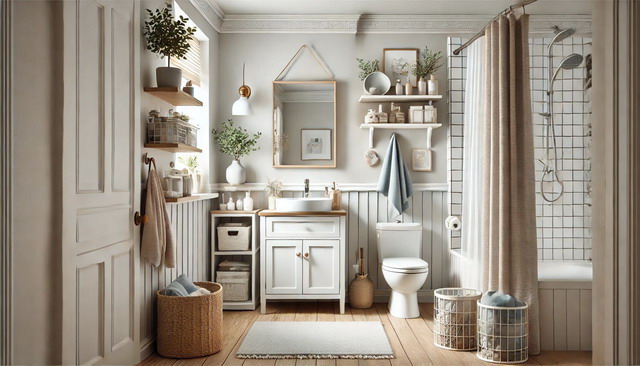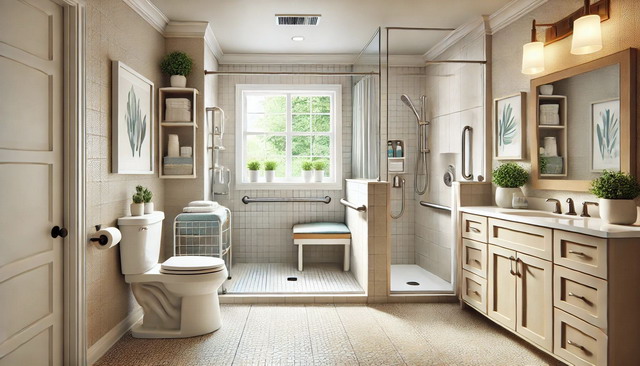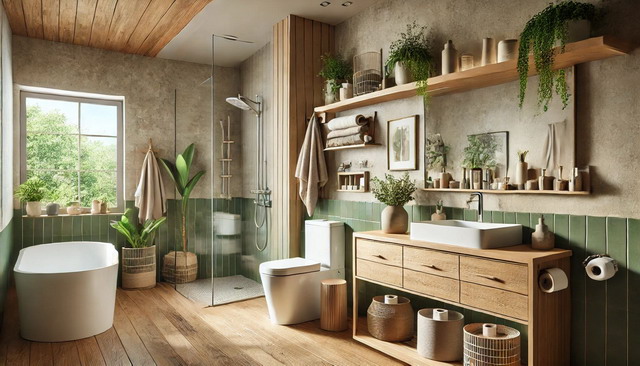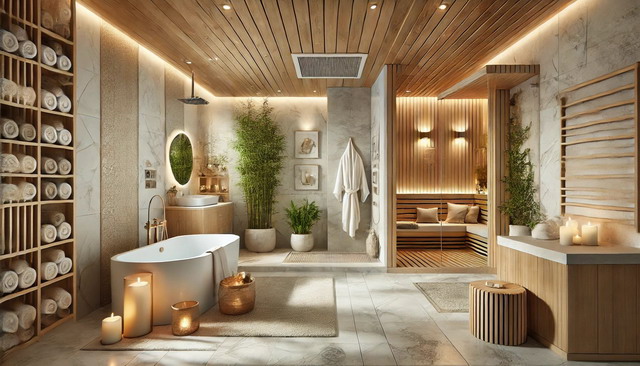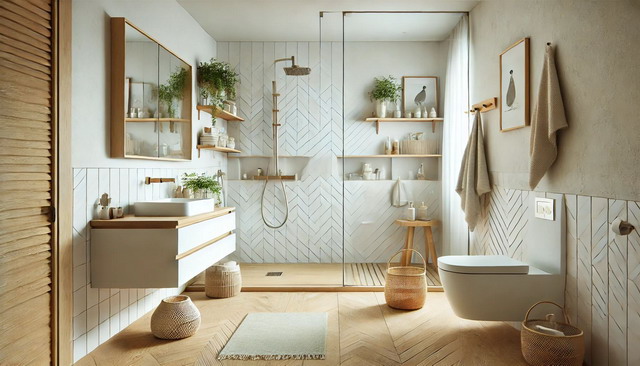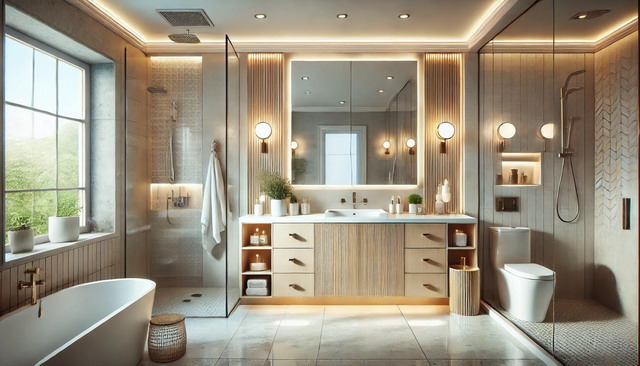Bathroom renovation trends are evolving rapidly, blending functionality with modern aesthetics to create serene sanctuaries within our homes. As I dove into the latest trends, I couldn’t help but get excited about the transformative potential of these ideas. Here’s a closer look at the top trends that are making waves in 2026.
Modern Minimalist Bathroom Renovation Ideas
Renovating a bathroom with a modern minimalist style involves focusing on simplicity, functionality, and elegance. Here are some key ideas to achieve a modern minimalist bathroom:
- Neutral Color Palette:
-
- Use a neutral color scheme with shades of white, gray, black, or beige. These colors create a clean and calming atmosphere.
- Consider matte finishes for a contemporary look.
- Clean Lines and Geometric Shapes:
- Minimalist Fixtures:
-
- Opt for sleek and simple fixtures like wall-mounted faucets, frameless mirrors, and minimal hardware.
- Choose a floating vanity to create a sense of space and openness.
- Functional Storage Solutions:
-
- Use built-in storage solutions such as recessed shelves, medicine cabinets, and floating shelves to keep the space clutter-free.
- Consider under-sink storage to maximize space.
- High-Quality Materials:
-
- Select high-quality materials like natural stone, porcelain, or ceramic tiles for durability and aesthetic appeal.
- Use glass for shower enclosures to maintain a spacious and open feel.
- Smart Lighting:
-
- Incorporate layered lighting with a combination of ambient, task, and accent lighting.
- Use LED strip lights under vanities or around mirrors for a modern touch.
- Simple and Elegant Accessories:
-
- Keep accessories minimal and functional, such as a simple soap dispenser, a sleek towel rack, and a few decorative elements like plants or candles.
- Avoid overdecorating to maintain a clean and uncluttered look.
- Open and Airy Layout:
-
- Design the layout to maximize space and create an open feel.
- Use large mirrors to reflect light and create the illusion of a larger space.
- Natural Elements:
-
- Introduce natural elements like wood accents or plants to add warmth and texture to the minimalist design.
- Use bamboo or teak for accessories and furniture to complement the modern aesthetic.
- Efficient Use of Space:
-
- Utilize every inch of the bathroom efficiently with smart design choices.
- Consider corner sinks, compact toilets, and space-saving bathtubs to optimize the layout.
Eco-friendly bathroom renovation materials
Eco-friendly bathroom renovation materials are designed to minimize environmental impact while providing a sustainable, durable, and aesthetically pleasing renovation solution. Here are some key eco-friendly materials to consider for bathroom renovation:
- Recycled Glass Tiles
- Sustainability: Made from recycled glass bottles and other glass products, reducing landfill waste.
- Durability: Highly durable and resistant to moisture and stains.
- Aesthetics: Available in various colors and finishes, adding a unique and vibrant look to your bathroom.
- Bamboo Flooring
- Sustainability: Bamboo is a rapidly renewable resource, growing much faster than traditional hardwoods.
- Durability: Strong, durable, and resistant to moisture, making it ideal for bathrooms.
- Aesthetics: Offers a warm, natural look and is available in a variety of finishes.
- Low-VOC Paints
- Sustainability: Low in volatile organic compounds (VOCs), which are harmful to the environment and human health.
- Durability: Provides a durable finish that resists mold and mildew.
- Aesthetics: Available in a wide range of colors and finishes, ensuring a beautiful and safe bathroom environment.
- Reclaimed Wood
- Sustainability: Uses wood that has been salvaged from old buildings, reducing the need for new lumber and preserving forests.
- Durability: Often stronger and more durable than new wood due to its age and previous exposure to the elements.
- Aesthetics: Adds a rustic, character-filled appearance to the bathroom.
- Natural Stone
- Sustainability: Sourced from nature and requires minimal processing, reducing environmental impact.
- Durability: Extremely durable and long-lasting, ideal for high-moisture areas like bathrooms.
- Aesthetics: Offers a timeless, elegant look with unique natural patterns.
- Water-Efficient Fixtures
- Sustainability: Reduces water consumption, conserving a precious natural resource.
- Durability: High-quality fixtures are built to last and often come with warranties.
- Aesthetics: Available in modern designs that complement various bathroom styles.
- Recycled Metal
- Sustainability: Made from recycled metal products, reducing the need for new mining and processing.
- Durability: Highly durable and resistant to corrosion.
- Aesthetics: Adds an industrial or modern touch to bathroom fixtures and hardware.
- Organic Cotton Towels and Linens
- Sustainability: Made from organically grown cotton, free from harmful pesticides and chemicals.
- Durability: Soft, absorbent, and long-lasting.
- Aesthetics: Available in various colors and designs, providing a luxurious feel.
- Cork Flooring
- Sustainability: Harvested from the bark of cork oak trees, which regenerates, making it a renewable resource.
- Durability: Naturally resistant to mold, mildew, and moisture.
- Aesthetics: Provides a soft, warm feel underfoot and comes in various styles and colors.
- Energy-Efficient Lighting
- Sustainability: Uses less electricity, reducing energy consumption and greenhouse gas emissions.
- Durability: LED lights have a longer lifespan compared to traditional bulbs.
- Aesthetics: Available in various designs and colors, enhancing the bathroom ambiance.
Using these eco-friendly materials in bathroom renovation not only contributes to a healthier planet but also creates a healthier living space. They often come with the added benefits of increased durability and unique aesthetic appeal.
Small bathroom renovation trends 2026
Here are some of the latest trends in small bathroom renovations for 2026:
- Compact Fixtures and Fittings
- Space-Saving Toilets and Vanities: Wall-mounted toilets and floating vanities are popular for maximizing floor space.
- Compact Bathtubs: Smaller, deep-soak tubs are in demand for those who want a bathtub without sacrificing space.
- Bold Tile Patterns
- Geometric and Mosaic Tiles: Eye-catching patterns can make a small bathroom feel more dynamic and stylish.
- Feature Walls: Using bold tiles on one wall as an accent to add character and depth.
- Smart Storage Solutions
- Built-In Shelving: Recessed shelves in showers and walls to save space.
- Multi-Functional Furniture: Vanities with built-in storage and mirrors with shelving.
- Light and Bright Colors
- Neutral Palettes: Whites, beiges, and soft grays make small spaces feel larger and more open.
- Accent Colors: Splashes of bold colors like navy, emerald green, or mustard yellow add personality without overwhelming the space.
- Innovative Lighting
- LED Mirrors and Backlit Panels: These provide both illumination and a modern aesthetic.
- Natural Light Maximization: Skylights and larger windows where possible to enhance the sense of space and openness.
- Sustainable Materials
- Eco-Friendly Tiles and Fixtures: Recycled materials and water-saving fixtures are gaining popularity.
- Natural Stone and Wood: Using sustainable wood and stone adds warmth and a touch of nature to the bathroom.
- Minimalist Design
- Clutter-Free Spaces: Clean lines, minimal accessories, and built-in storage keep the bathroom looking sleek and organized.
- Open Shelving: While maintaining minimalism, open shelving can provide an airy feel and easy access to essentials.
- High-Tech Features
- Smart Showers and Faucets: Features like temperature control, water usage monitoring, and touchless operation.
- Heated Floors and Towel Racks: Adding comfort and luxury to small spaces.
- Textured Finishes
- Matte and Brushed Finishes: These finishes are popular for fixtures as they offer a modern, understated elegance.
- Textured Wall Panels: Adding dimension and interest without taking up space.
- Efficient Layouts
- Corner Sinks and Toilets: Utilizing corners efficiently to free up more usable space.
- Wet Rooms: Combining the shower area with the rest of the bathroom space for a seamless and spacious feel.
By integrating these trends, homeowners can create functional, stylish, and modern small bathrooms that feel larger and more inviting.
Luxury Bathroom Renovation Design Trends
- Spa-like Retreats
- Features: Incorporate elements such as rain showers, freestanding soaking tubs, and steam rooms to create a spa-like experience.
- Materials: Use natural stones, wood accents, and high-quality tiles for a serene and luxurious feel.
- Lighting: Soft, ambient lighting enhances the relaxing atmosphere.
- Smart Technology
- Integration: Smart mirrors, temperature-controlled showers, and automated lighting systems are becoming standard in luxury bathrooms.
- Convenience: Features like voice-activated controls and app-based management systems offer unparalleled convenience and customization.
- Minimalist Aesthetics
- Design: Clean lines, clutter-free spaces, and a focus on simplicity and functionality.
- Colors: Neutral color palettes with shades of white, gray, and beige dominate, creating a calm and sophisticated look.
- Storage: Hidden storage solutions to maintain a sleek and organized appearance.
- High-end Fixtures and Finishes
- Fixtures: Statement pieces such as gold or matte black faucets, designer sinks, and unique hardware add a touch of opulence.
- Finishes: Use of marble, quartz, and other luxurious materials for countertops and backsplashes.
- Customization and Personalization
- Bespoke Designs: Tailored solutions that reflect personal style and preferences, from custom vanities to unique tile patterns.
- Personal Touches: Incorporating art, unique décor items, and custom-built furniture to make the space truly unique.
- Sustainable and Eco-friendly Designs
- Materials: Use of sustainable materials such as bamboo, recycled glass, and low-VOC paints.
- Water Efficiency: Installation of water-saving fixtures and appliances to reduce environmental impact.
- Large, Open Spaces
- Layout: Emphasis on creating spacious, open layouts that promote a sense of luxury and freedom.
- Features: Walk-in showers, double vanities, and expansive mirrors contribute to the open feel.
- Nature-inspired Elements
- Incorporation: Elements such as indoor plants, natural textures, and water features to bring the tranquility of nature indoors.
- Design: Use of earthy tones and organic shapes to create a harmonious and calming environment.
These trends reflect a growing desire for bathrooms that are not only functional but also serve as luxurious retreats within the home. Incorporating these elements can elevate a bathroom renovation to a new level of sophistication and comfort.
Budget-friendly bathroom renovation tips
Here are some budget-friendly tips for renovating your bathroom:
Planning and Budgeting
- Set a Budget: Determine how much you’re willing to spend and stick to it. This helps prioritize what needs the most attention.
- Plan Ahead: Make a detailed plan before starting the renovation to avoid unexpected expenses.
DIY Solutions
- Do It Yourself: Handle small tasks yourself, such as painting, replacing fixtures, or installing new accessories.
- Reuse and Repurpose: Reuse existing fixtures if they are in good condition. Repurpose old furniture for storage or decor.
Cost-Effective Upgrades
- Paint Instead of Replace: Instead of replacing tiles or cabinets, consider painting them for a fresh look.
- Affordable Flooring: Use peel-and-stick tiles or vinyl flooring for an affordable yet stylish upgrade.
Smart Shopping
- Shop Sales and Discounts: Look for sales, discounts, or second-hand items for fixtures, tiles, and accessories.
- Buy in Bulk: Purchase materials in bulk to save money, especially if you’re doing multiple projects.
Efficient Use of Space
- Maximize Space: Use wall-mounted shelves and cabinets to free up floor space and create more storage.
- Shower Curtain Swap: Replace glass shower doors with a stylish shower curtain to save on costs.
Small Changes, Big Impact
- Update Fixtures: Change faucets, showerheads, and cabinet handles for an instant update.
- Lighting: Improve lighting with energy-efficient LED fixtures to make the space brighter and more inviting.
Professional Help
- Hire Wisely: If you need professional help, hire contractors for essential work only and ensure they are cost-effective.
By following these tips, you can achieve a stylish and functional bathroom renovation without breaking the bank.
Innovative Storage Solutions for Bathroom Renovation
- Wall-mounted Cabinets: Wall-mounted cabinets are a great way to save floor space while adding storage. They can be installed above the sink or toilet, providing ample room for toiletries and bathroom essentials without taking up valuable floor space.
- Recessed Shelving: Recessed shelving built into the wall adds storage space without protruding into the room. These shelves are perfect for storing items like towels, soap, and other toiletries, and they can be customized to fit the design and layout of your bathroom.
- Over-the-toilet Storage: Utilizing the space above the toilet is an efficient way to add storage. Over-the-toilet shelves or cabinets can hold extra toilet paper, towels, and decorative items, keeping them within reach but out of the way.
- Vanity with Drawers: A bathroom vanity with multiple drawers provides organized storage for various items. Drawers can be equipped with dividers to keep things tidy and easily accessible, making it a practical choice for bathroom renovation.
- Floating Shelves: Floating shelves are a stylish and functional addition to any bathroom. They can be placed anywhere on the walls, offering flexible storage solutions for items like plants, candles, and decorative pieces, enhancing the aesthetic appeal of the space.
- Built-in Shower Niches: Installing niches in the shower walls can create dedicated storage for shampoo, conditioner, and other shower essentials. These niches keep items off the floor and within easy reach, adding both convenience and style to the shower area.
- Mirror Cabinets: Mirrors with built-in cabinets behind them provide hidden storage space for toiletries and medicines. These cabinets maximize wall space and keep items concealed, contributing to a clean and organized bathroom appearance.
- Under-sink Organizers: Utilizing the space under the sink with organizers or pull-out drawers can significantly increase storage capacity. These solutions make it easier to access items stored at the back and keep the area neat and tidy.
- Corner Shelves: Corner shelves make use of often-overlooked spaces in the bathroom. They can be installed in corners near the sink, shower, or bathtub to hold toiletries, plants, or decorative items, optimizing the use of available space.
- Multi-functional Furniture: Furniture that serves dual purposes, such as a bench with storage compartments or a laundry hamper with a flat surface on top, can add functionality and storage without cluttering the bathroom.
Implementing these innovative storage solutions can transform a cluttered bathroom into an organized and efficient space, enhancing both its functionality and aesthetic appeal.
Popular tile designs for bathroom renovations
When considering bathroom renovations, popular tile designs play a significant role in defining the space’s aesthetics and functionality. Here are some popular tile designs for bathroom renovations:
- Subway Tiles
- Description: Classic rectangular tiles often installed in a brick-like pattern.
- Advantages: Timeless, versatile, easy to clean, and pairs well with various styles.
- Use Case: Commonly used for shower walls, backsplashes, and sometimes flooring.
- Mosaic Tiles
- Description: Small tiles, often made of glass, ceramic, or natural stone, arranged to create intricate patterns.
- Advantages: Adds texture, visual interest, and can create stunning accent areas.
- Use Case: Ideal for shower floors, accent walls, and borders.
- Hexagonal Tiles
- Description: Six-sided tiles that offer a modern geometric look.
- Advantages: Unique, stylish, and available in various sizes and colors.
- Use Case: Suitable for both floors and walls, often used to create feature walls or floors.
- Marble Tiles
- Description: Natural stone tiles known for their luxurious appearance and veining patterns.
- Advantages: Elegant, timeless, and adds value to the property.
- Use Case: Best for floors, walls, and vanity tops, but requires sealing and maintenance.
- Patterned Tiles
- Description: Tiles with intricate designs or motifs, often inspired by traditional or cultural patterns.
- Advantages: Adds personality, visual interest, and can make a bold statement.
- Use Case: Perfect for feature walls, floors, and backsplashes.
- Large Format Tiles
- Description: Tiles that are larger than the standard size, often 12×24 inches or bigger.
- Advantages: Creates a sense of spaciousness, fewer grout lines, and a modern look.
- Use Case: Ideal for both floors and walls, particularly in smaller bathrooms to make the space appear larger.
- Wood-Look Tiles
- Description: Porcelain or ceramic tiles that mimic the appearance of natural wood.
- Advantages: Combines the warmth of wood with the durability and water resistance of tile.
- Use Case: Great for floors and walls, providing a cozy, spa-like atmosphere.
- Penny Tiles
- Description: Small, round tiles that can create a charming and retro look.
- Advantages: Adds texture and interest, slip-resistant when used on floors.
- Use Case: Commonly used for shower floors, walls, and backsplashes.
- Natural Stone Tiles
- Description: Tiles made from materials like granite, limestone, or travertine.
- Advantages: Unique natural patterns, durable, and adds a touch of nature.
- Use Case: Suitable for floors, walls, and shower areas, though they require sealing.
- Geometric Tiles
- Description: Tiles with geometric shapes and patterns, including triangles, diamonds, and more.
- Advantages: Modern, bold, and can create striking visual effects.
- Use Case: Ideal for accent walls, backsplashes, and feature floors.
When choosing tile designs for a bathroom renovation, consider the overall style you want to achieve, the maintenance required, and how the tiles will complement other elements in the bathroom. Mixing and matching different types of tiles can also create a unique and personalized look.
Vintage-inspired bathroom renovation trends
Vintage-inspired bathroom renovation trends combine classic elements from the past with modern functionality, creating a timeless and elegant look. Here are some key features and trends associated with vintage-inspired bathroom renovations:
- Clawfoot Tubs:
- Description: Freestanding tubs with ornate feet.
- Trend: These tubs bring a luxurious and classic feel to the bathroom, often becoming the focal point of the design.
- Subway Tiles:
- Description: Small, rectangular tiles, often white.
- Trend: Used on walls and in showers, they provide a clean, retro look that harks back to early 20th-century bathrooms.
- Hexagon and Penny Tiles:
- Description: Small hexagonal or round tiles.
- Trend: Commonly used for flooring, these tiles add a vintage touch with their intricate patterns and classic appeal.
- Pedestal Sinks:
- Description: Stand-alone sinks without cabinetry.
- Trend: They offer a streamlined and airy look, often paired with traditional faucets for a cohesive vintage style.
- Vintage Fixtures and Hardware:
- Description: Antique or vintage-style faucets, handles, and showerheads.
- Trend: Brass, bronze, and polished nickel finishes are popular choices, adding a touch of authenticity and elegance.
- Patterned Wallpaper:
- Description: Wallpaper with classic patterns such as floral, damask, or geometric designs.
- Trend: Used as an accent wall or throughout the bathroom, it enhances the vintage ambiance with a touch of charm and nostalgia.
- Freestanding Vanities:
- Description: Vanities that mimic antique furniture.
- Trend: These vanities often feature detailed woodwork and are paired with marble or granite countertops to blend vintage aesthetics with modern luxury.
- Vintage Lighting:
- Description: Fixtures that resemble antique designs, such as sconces and chandeliers.
- Trend: Lighting plays a crucial role in setting the mood, with vintage-inspired fixtures providing warmth and character.
- Color Palette:
- Description: Soft, muted colors such as pastels, whites, and creams.
- Trend: These colors create a serene and timeless look, often accented with darker tones like navy or black for contrast.
- Wainscoting and Paneling:
- Description: Wood paneling applied to the lower half of walls.
- Trend: This traditional feature adds texture and depth, enhancing the vintage feel of the bathroom.
By incorporating these elements, a vintage-inspired bathroom can achieve a perfect balance of old-world charm and contemporary convenience, resulting in a space that feels both nostalgic and fresh.
Smart Technology in Bathroom Renovations
Smart technology is revolutionizing the way we approach bathroom renovations, making them more efficient, comfortable, and sustainable. Here’s a detailed explanation of how smart technology is being integrated into modern bathrooms:
- Smart Showers:
- Temperature Control: Smart showers can be programmed to reach the desired temperature before you step in, saving water and energy.
- Voice Activation: Some models are compatible with virtual assistants like Alexa or Google Home, allowing for voice commands to control the shower.
- Water Usage Monitoring: These showers provide data on water usage, helping you conserve water and reduce utility bills.
- Intelligent Toilets:
- Automated Functions: Features such as automatic flushing, lid opening/closing, and seat warming enhance convenience and hygiene.
- Bidet Functions: Integrated bidets with adjustable water pressure and temperature settings improve personal hygiene.
- Self-Cleaning: Advanced toilets come with self-cleaning functions, using UV light or electrolyzed water to keep the bowl clean.
- Smart Mirrors:
- Integrated Displays: Smart mirrors can display the weather, news, and personal calendar, turning your bathroom into an information hub.
- Anti-Fog Technology: Built-in anti-fog features ensure a clear reflection even after a hot shower.
- LED Lighting: Adjustable lighting options help in creating the perfect ambiance and aid in activities like shaving or applying makeup.
- Smart Lighting:
- Motion Sensors: Lights that turn on and off automatically with motion sensors improve energy efficiency.
- Color and Intensity Control: Adjustable color temperature and brightness settings can be controlled via a smartphone app or voice commands.
- Mood Lighting: Programmable lighting scenarios can create a relaxing spa-like atmosphere.
- Automated Faucets:
- Touchless Operation: Motion-sensing faucets reduce the spread of germs and are more hygienic.
- Temperature Control: These faucets allow precise temperature adjustments, ensuring comfort and safety.
- Heated Floors:
- Programmable Thermostats: Heated floors with programmable thermostats provide consistent warmth, improving comfort, especially during colder months.
- Energy Efficiency: Smart systems can optimize energy use, reducing heating costs.
- Leak Detection and Water Management:
- Sensors: Leak detection sensors alert you to any water leaks, preventing potential water damage and saving on repairs.
- Automatic Shutoff: Some systems can automatically shut off the water supply when a leak is detected.
- Smart Ventilation:
- Humidity Sensors: Smart ventilation systems with humidity sensors ensure proper ventilation, reducing mold and mildew growth.
- Air Quality Monitoring: These systems can monitor and improve indoor air quality, promoting a healthier environment.
Integrating smart technology into bathroom renovations not only enhances convenience and comfort but also promotes sustainability by optimizing water and energy use. The initial investment in smart technology can lead to long-term savings and an improved quality of life.
DIY Bathroom Renovation Ideas and Tips
Renovating a bathroom can be a rewarding project, and doing it yourself (DIY) can save a lot of money. Here are some ideas and tips to guide you through a successful DIY bathroom renovation:
1. Plan Your Renovation
- Assess Your Needs: Determine what needs to be replaced or upgraded (e.g., fixtures, tiles, paint).
- Budgeting: Set a budget for the renovation and try to stick to it.
- Design: Create a design plan for the new layout and style. Consider functionality and aesthetics.
2. Demolition
- Preparation: Remove all the items from the bathroom and cover areas that need protection.
- Safety: Wear protective gear like gloves, goggles, and a mask.
- Remove Fixtures: Carefully remove old fixtures such as the sink, toilet, and shower.
3. Plumbing and Electrical Work
- Hire Professionals: If the renovation requires moving plumbing or electrical components, it’s best to hire professionals.
- DIY Upgrades: Replace faucets, showerheads, and light fixtures to give the bathroom a fresh look.
4. Walls and Flooring
- Tiles: Replace old tiles with new ones. Consider modern styles like subway tiles or geometric patterns.
- Paint: Choose moisture-resistant paint for the bathroom walls. Light colors can make the space feel larger.
- Flooring: Opt for durable and water-resistant flooring options like ceramic tiles or vinyl.
5. Fixtures and Fittings
- Vanity: Replace the old vanity with a new one that offers more storage and complements the bathroom design.
- Toilet: Consider a modern, water-saving toilet model.
- Shower/Bath: Install a new shower or bath. If space is limited, a walk-in shower can be a great option.
6. Storage Solutions
- Shelving: Install floating shelves or cabinets to keep the bathroom organized.
- Hooks and Racks: Add hooks for towels and racks for toiletries to maximize space.
7. Final Touches
- Lighting: Ensure the bathroom is well-lit. Consider adding a combination of ambient, task, and accent lighting.
- Accessories: Add stylish accessories like mirrors, towel bars, and decorative items to enhance the overall look.
8. Tips for Success
- Take Your Time: Don’t rush the renovation. Take the time to do it right.
- Measure Twice: Always double-check measurements before cutting or installing materials.
- Seek Inspiration: Look for inspiration online or in magazines to get ideas and visualize the final result.
- Stay Organized: Keep your tools and materials organized to avoid any delays.
Bathroom Renovation Trends for Aging in Place
As the population ages, many homeowners are looking to renovate their bathrooms to make them safer and more functional for aging in place. Here are some of the key trends in bathroom renovations that cater to the needs of older adults:
1. Walk-In Showers and Tubs
- Walk-In Showers: These showers eliminate the need to step over a high threshold, reducing the risk of falls. They often include features like non-slip floors, built-in benches, and handheld showerheads.
- Walk-In Tubs: These tubs come with a door that opens to allow easy entry and exit. They often include built-in seats and grab bars for added safety.
2. Grab Bars and Handrails
- Strategically placed grab bars and handrails provide support and stability. They are often installed near toilets, showers, and tubs to help with balance and mobility.
3. Non-Slip Flooring
- Non-slip tiles or vinyl flooring can significantly reduce the risk of slips and falls. Textured finishes provide better traction compared to smooth surfaces.
4. Adjustable Showerheads and Handheld Sprayers
- Adjustable-height showerheads and handheld sprayers offer flexibility and ease of use. They can be positioned at various heights to accommodate different users.
5. Comfort-Height Toilets
- Also known as ADA-compliant toilets, these toilets are higher than standard models, making it easier to sit down and stand up. This reduces strain on the knees and back.
6. Lever-Style Faucets
- Lever handles are easier to use than traditional knobs, especially for individuals with arthritis or limited hand strength. They require less force to operate and can be used with a closed fist or elbow.
7. Enhanced Lighting
- Adequate lighting is crucial for safety and ease of use. LED lights, motion-sensor lighting, and illuminated switches can improve visibility and reduce the risk of accidents.
8. Storage Solutions
- Accessible storage solutions, such as pull-out shelves, lazy Susans, and wall-mounted cabinets, keep essentials within easy reach and reduce the need to bend or stretch.
9. Temperature Control
- Anti-scald devices and thermostatic valves can prevent sudden changes in water temperature, protecting against burns. These are especially important for older adults with reduced sensitivity to temperature.
10. Widened Doorways
- Widening doorways to at least 32 inches can accommodate walkers or wheelchairs, making the bathroom more accessible for individuals with mobility aids.
11. Seated Vanity Areas
- A seated vanity area with a lower countertop allows users to sit while grooming, reducing the risk of fatigue and falls.
Sustainable Bathroom Renovation Practices
Sustainable bathroom renovation involves incorporating eco-friendly materials, efficient water usage, and energy-saving designs to minimize environmental impact. Here are key practices to achieve a sustainable bathroom renovation:
- Water Efficiency:
- Low-Flow Fixtures: Install low-flow toilets, faucets, and showerheads to reduce water usage without compromising performance.
- Dual-Flush Toilets: Use dual-flush toilets that offer different flushing options for liquid and solid waste, further conserving water.
- Energy Efficiency:
- LED Lighting: Replace traditional lighting with LED bulbs, which consume less energy and have a longer lifespan.
- Energy-Efficient Water Heaters: Consider tankless or solar water heaters that provide hot water on demand, reducing energy consumption.
- Eco-Friendly Materials:
- Recycled and Reclaimed Materials: Use recycled tiles, reclaimed wood, and other sustainable materials to reduce the demand for new resources.
- Low-VOC Paints: Choose paints and finishes with low volatile organic compound (VOC) levels to improve indoor air quality.
- Sustainable Flooring:
- Bamboo or Cork Flooring: Opt for bamboo or cork flooring, which are renewable resources and provide durability and aesthetic appeal.
- Recycled Tiles: Use tiles made from recycled glass or ceramic, which are both eco-friendly and stylish.
- Water-Saving Landscaping:
- Native Plants: If your bathroom has access to an outdoor space, use native plants that require less water and maintenance.
- Rainwater Harvesting: Implement systems to collect and use rainwater for non-potable purposes, such as flushing toilets or watering plants.
- Waste Reduction:
- Efficient Demolition: During renovation, minimize waste by carefully deconstructing and recycling materials rather than demolishing and discarding them.
- Composting Toilets: Consider composting toilets in off-grid or eco-friendly homes to reduce water use and create compost for gardening.
- Indoor Air Quality:
- Ventilation: Ensure proper ventilation to reduce humidity and mold growth, which can improve indoor air quality and prolong the life of bathroom materials.
- Natural Cleaning Products: Use environmentally friendly cleaning products that are free from harsh chemicals to maintain a healthy indoor environment.
- Sustainable Design:
- Timeless Design: Choose a timeless design that reduces the need for frequent renovations, thereby conserving resources over time.
- Smart Technology: Integrate smart technology to monitor and control water and energy usage efficiently.
Spa-like Bathroom Renovation Inspirations
Creating a spa-like bathroom involves incorporating elements that promote relaxation, luxury, and a sense of tranquility. Here are some key inspirations for achieving a spa-like atmosphere in your bathroom renovation:
- Neutral Color Palette:
- Use calming, neutral colors such as whites, beiges, and soft grays.
- These colors create a serene environment and make the space feel larger and more open.
- Natural Materials:
- Incorporate natural materials like wood, stone, and bamboo.
- Wooden vanities, stone countertops, and bamboo accessories add a touch of nature and warmth.
- Luxurious Fixtures:
- Opt for high-quality fixtures like rainfall showerheads, freestanding bathtubs, and elegant faucets.
- These elements enhance the luxurious feel of the bathroom.
- Spa-like Accessories:
- Add elements such as plush towels, bathrobes, and bath mats.
- Use decorative items like candles, essential oil diffusers, and plants to enhance relaxation.
- Ambient Lighting:
- Install dimmable lighting to create a soothing atmosphere.
- Consider adding LED strip lights under cabinets or around mirrors for a soft glow.
- Walk-in Showers and Soaking Tubs:
- Design a spacious walk-in shower with glass doors for an open and airy feel.
- Include a deep soaking tub for ultimate relaxation.
- Ample Storage:
- Ensure there is plenty of storage to keep the bathroom clutter-free.
- Use built-in shelves, medicine cabinets, and vanity drawers to store essentials neatly.
- Greenery and Nature Elements:
- Introduce plants that thrive in humid environments, such as ferns or orchids.
- Consider a living wall or vertical garden for a striking natural feature.
- Textures and Patterns:
- Mix different textures and patterns to add visual interest.
- Use textured tiles, patterned wallpapers, or woven baskets to enhance the spa-like ambiance.
- Sound and Aroma:
- Incorporate a sound system to play soothing music or nature sounds.
- Use aromatherapy with essential oils like lavender or eucalyptus to create a calming scent.
Scandinavian bathroom renovation styles
Scandinavian bathroom renovation styles are characterized by their simplicity, functionality, and elegance. Here are key features and elements commonly found in Scandinavian bathroom designs:
Key Features of Scandinavian Bathroom Renovation Styles:
- Minimalism:
- Scandinavian bathrooms focus on minimalism, with clean lines and uncluttered spaces.
- The design emphasizes functionality and avoids unnecessary decorations.
- Neutral Color Palette:
- A neutral color palette dominates Scandinavian bathrooms. Whites, grays, and blacks are commonly used.
- Light colors help create a sense of space and brightness, essential for the often darker Scandinavian winters.
- Natural Materials:
- Use of natural materials like wood and stone adds warmth and texture to the bathroom.
- Wooden elements, such as vanities, shelves, and accents, are often left in their natural state or lightly stained.
- Ample Lighting:
- Good lighting is crucial, with a focus on natural light. Large windows or skylights are common.
- Artificial lighting typically includes sleek, modern fixtures, often with LED lights to ensure brightness and energy efficiency.
- Functional Furniture:
- Scandinavian design emphasizes practical and functional furniture.
- Vanities, cabinets, and shelving are designed to maximize storage without overwhelming the space.
- Clean and Simple Lines:
- Fixtures and fittings, such as faucets and handles, are often simple and sleek.
- The overall design avoids ornate or overly decorative elements.
- White Subway Tiles:
- White subway tiles are a popular choice for walls and backsplashes.
- These tiles create a clean and timeless look, enhancing the sense of space and brightness.
- Contrasting Elements:
- Black or dark-colored fixtures (e.g., faucets, showerheads) provide a striking contrast against the predominantly light color scheme.
- This contrast adds depth and a modern edge to the design.
- Greenery:
- Incorporating plants adds a touch of nature and freshness.
- Plants like ferns, succulents, or even small potted trees can thrive in the bathroom environment and enhance the serene atmosphere.
- Efficient Use of Space:
- Scandinavian bathrooms often include smart storage solutions to keep the space tidy.
- Built-in shelves, drawers, and niches help in maintaining a clutter-free environment.
Best lighting options for bathroom renovations
When considering the best lighting options for bathroom renovations, it’s important to think about both functionality and aesthetics. Here are some key points to consider:
- Layered Lighting
Layered lighting combines different types of lights to create a balanced and visually appealing space. This typically includes:
- Ambient Lighting: Provides overall illumination for the room. This can be achieved with ceiling-mounted fixtures, recessed lights, or a combination of both.
- Task Lighting: Focuses on specific areas where you need more light, such as around the vanity mirror. Vanity lights or wall sconces are ideal for this purpose.
- Accent Lighting: Highlights architectural features or decorative elements in the bathroom. This can be achieved with LED strips or spotlights.
- Types of Light Fixtures
- Ceiling Fixtures: Flush mounts or semi-flush mounts are common for providing ambient lighting.
- Recessed Lighting: These are ideal for ambient lighting, especially in showers and over bathtubs, as they provide a clean and modern look.
- Vanity Lights: Positioned on either side of the mirror or above it, vanity lights are essential for grooming tasks.
- Wall Sconces: These can be placed around the mirror or in other strategic locations to provide additional task lighting and decorative appeal.
- Pendant Lights: For a stylish touch, pendant lights can be used over the vanity area or in the center of the bathroom.
- Lighting Temperature and Bulbs
- LED Bulbs: These are energy-efficient, long-lasting, and available in various color temperatures.
- Color Temperature: Aim for a natural white light (around 3000K to 4000K) for task areas to provide clear and accurate lighting. For a more relaxed ambiance, you can use warmer lights (2700K to 3000K) in other areas of the bathroom.
- Dimmable Options
Incorporating dimmable lights allows you to adjust the brightness according to your needs. This is particularly useful for creating a relaxing atmosphere during a bath or providing bright light for tasks.
- Placement and Installation
- Vanity Lighting: Ideally, lights should be placed at eye level on either side of the mirror to minimize shadows on the face. Alternatively, a light bar or strip above the mirror can be used.
- Shower and Tub Areas: Ensure these areas are well-lit with waterproof fixtures. Recessed lighting is a popular choice here.
- General Lighting: Ensure even distribution of light across the entire bathroom to avoid dark spots.
- Safety Considerations
- Waterproof Fixtures: Use fixtures rated for damp or wet locations, especially in areas near water sources like the shower, bathtub, and sink.
- Proper Wiring: Ensure all electrical work is done by a licensed electrician to prevent any safety hazards.

